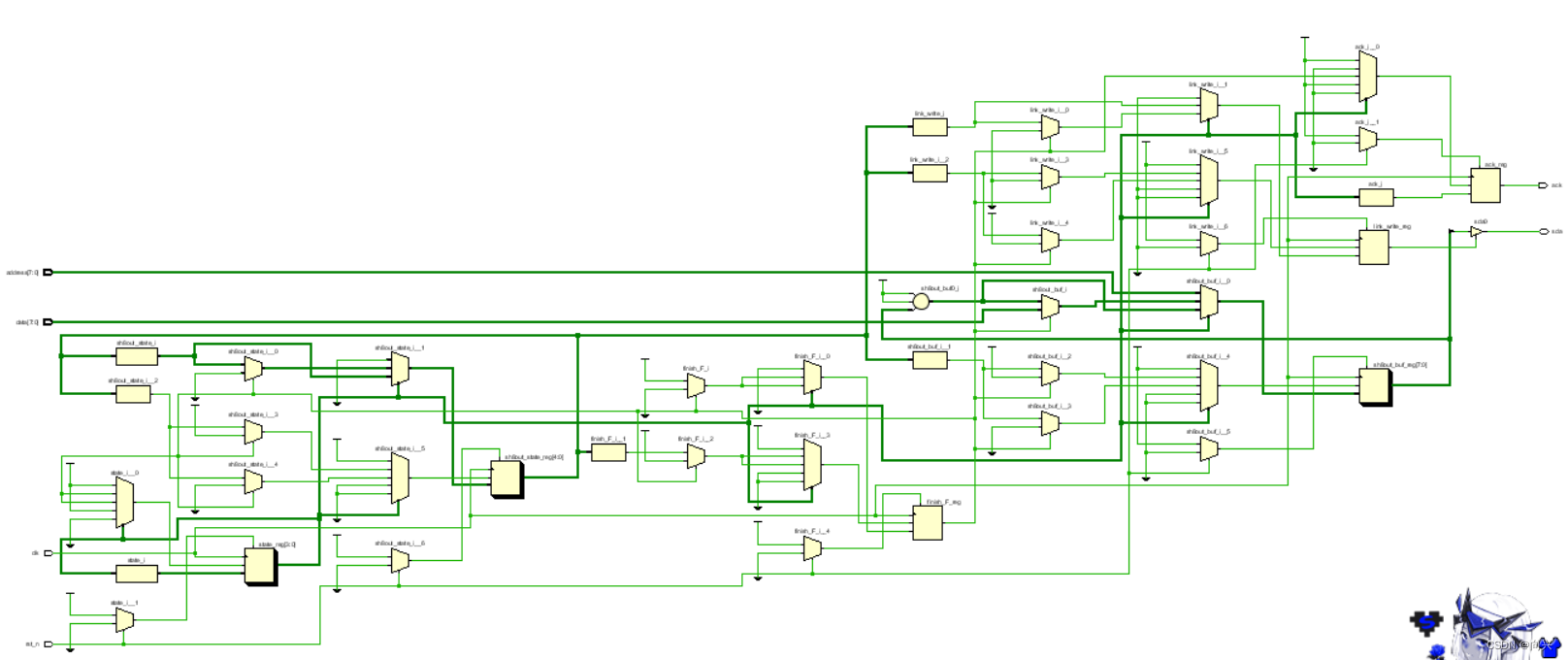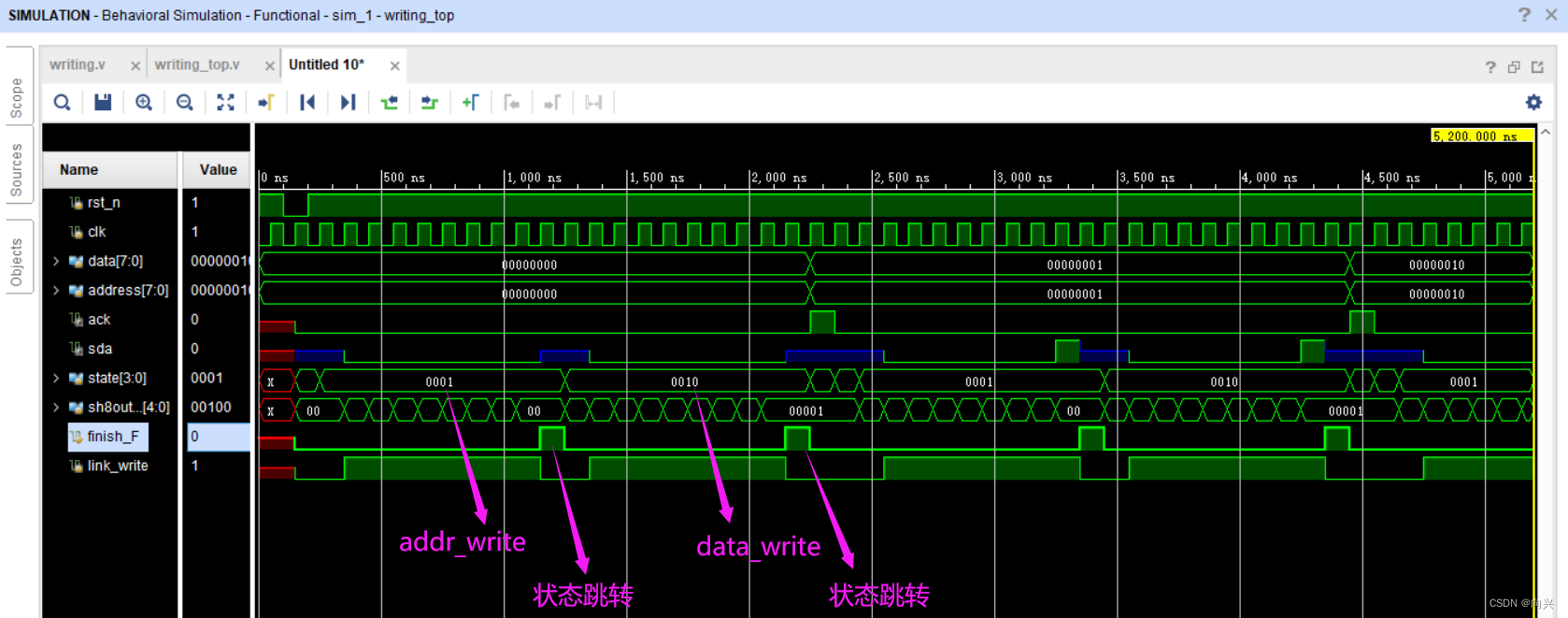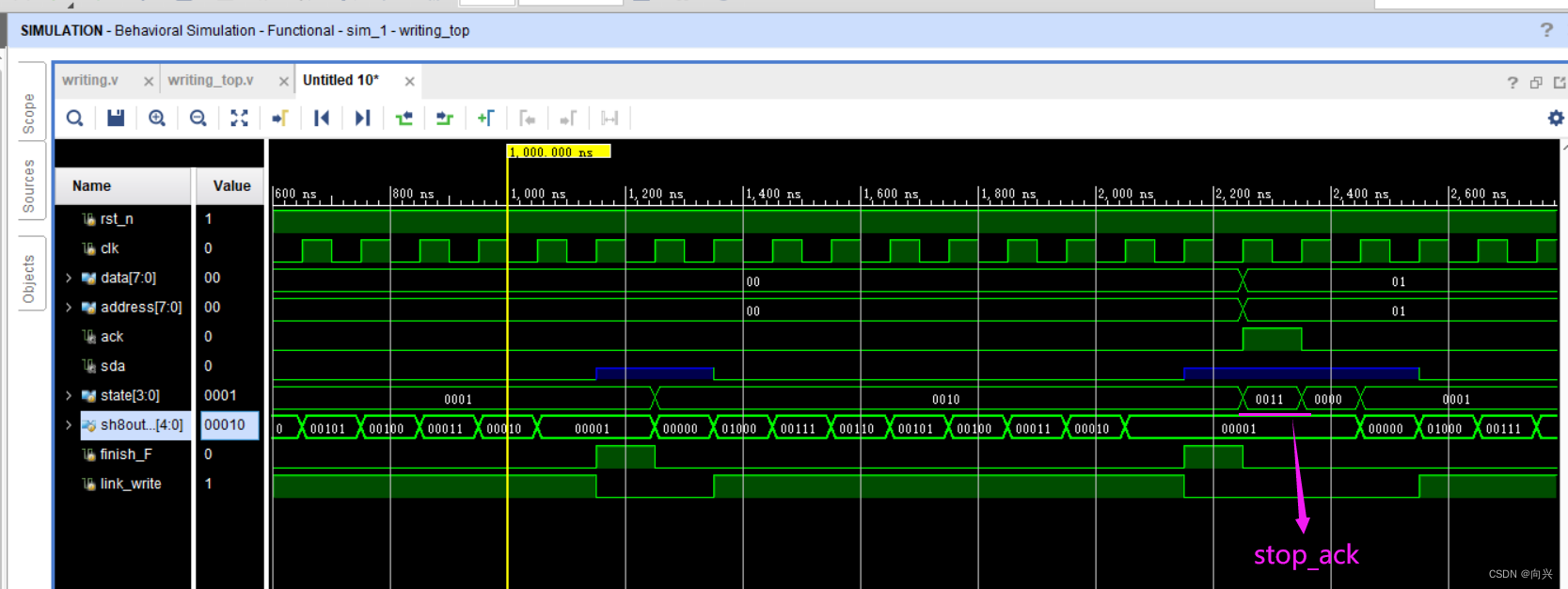练习九-利用状态机实现比较复杂的接口设计
- 1,任务目的:
- 2,RTL代码
- 3,RTL原理框图
- 4,测试代码
- 5,波形输出
1,任务目的:
(1)学习运用状态机控制的逻辑开关,并设计出一个比较复杂的接口逻辑;
(2)在复杂设计中使用任务(task)结构,以提高程序的可读性;
(3)加深对可综合风格模块的认识。
下面例子是一个并行数据转换为串行位流的变换器,利用双向总线输出。该案例来自于EPROM读写器,电路工作的步骤是:
(1)把并行地址存入寄存器; (2)把并行数据存入寄存器; (3)连接串行单总线; (4)地址的串行输出; (5)数据的串行输出; (6)挂起串行单总线; (7)给信号源应答; (8)让信号源给出下一个操作对象; (9)结束写操作。
2,RTL代码
`timescale 1ns / 1ps
//
// Company:
// Engineer:
//
// Create Date: 2023/11/22 10:52:02
// Design Name:
// Module Name: writing
// Project Name:
// Target Devices:
// Tool Versions:
// Description:
//
// Dependencies:
//
// Revision:
// Revision 0.01 - File Created
// Additional Comments:
//
//module writing(
rst_n, clk, address, data, sda, ack);input rst_n, clk;
input [7:0] data, address;inout sda; // 串行数据的输出或者输入接口
output ack; // 模块给出的应答信号
reg link_write; // link_write决定何时输出reg [3:0] state; // 主状态机的状态字
reg [4:0] sh8out_state; // 从状态机的状态字
reg [7:0] sh8out_buf; // 输入数据缓冲
reg finish_F; // 用以判断是否处理完一个操作对象
reg ack;parameter idle = 0;
parameter addr_write = 1;
parameter data_write = 2;
parameter stop_ack = 3;parameter bit0 = 1;
parameter bit1 = 2;
parameter bit2 = 3;
parameter bit3 = 4;
parameter bit4 = 5;
parameter bit5 = 6;
parameter bit6 = 7;
parameter bit7 = 8;assign sda = link_write ? sh8out_buf[7] : 1'bz;always@(posedge clk) beginif(!rst_n) begin // 复位link_write <= 0; // 挂起串行总线sh8out_state <= idle;sh8out_buf <= 0;state <= idle;finish_F <= 0; // 结束标志清零ack <= 0;endelse case(state)idle: beginlink_write <= 0; // 断开串行单总线sh8out_state <= idle;sh8out_buf <= address; // 并行地址存入寄存器state <= addr_write; // 进入下一个状态finish_F <= 0; ack <= 0;endaddr_write: // 地址的输入if(finish_F == 0) shift8_out ; // 地址的串行输出// ? 任务else beginsh8out_state <= idle;sh8out_buf <= data; // 并行数据存入寄存器state <= data_write;finish_F <= 0;enddata_write: // 数据的写入if(finish_F == 0)shift8_out ; // 数据的串行输出// 任务else beginlink_write <= 0;state <= stop_ack;finish_F <= 0;ack <= 1; // 向信号源发出应答endstop_ack: begin // 向信号源发出应答结果ack <= 0;state <= idle;endendcase
endtask shift8_out; // 地址和数据的串行输出
begincase(sh8out_state)idle: beginlink_write <= 1; // 连接串行单总线,立即输出地址或数据的最高位(MSB)sh8out_state <= bit7;endbit7: beginlink_write <= 1; // 连接串行单总线sh8out_state <= bit6;sh8out_buf <= sh8out_buf << 1; // 输出地址或数据的次高位(bit6)endbit6: beginsh8out_state <= bit5;sh8out_buf <= sh8out_buf << 1;endbit5: beginsh8out_state <= bit4;sh8out_buf <= sh8out_buf << 1;endbit4: beginsh8out_state <= bit3;sh8out_buf <= sh8out_buf << 1;endbit3: beginsh8out_state <= bit2;sh8out_buf <= sh8out_buf << 1;endbit2: beginsh8out_state <= bit1;sh8out_buf <= sh8out_buf << 1;endbit1: beginsh8out_state <= bit0;sh8out_buf <= sh8out_buf << 1; // 输出地址或数据的最低位(LSB)endbit0: beginlink_write <= 0; // 挂起串行单总线finish_F <= 1; // 建立结束标志endendcase
end
endtaskendmodule3,RTL原理框图

4,测试代码
`timescale 1ns / 1ps
//
// Company:
// Engineer:
//
// Create Date: 2023/11/22 10:53:46
// Design Name:
// Module Name: writing_top
// Project Name:
// Target Devices:
// Tool Versions:
// Description:
//
// Dependencies:
//
// Revision:
// Revision 0.01 - File Created
// Additional Comments:
//
//// 测试代码
`define clk_cycle 50
module writing_top;
reg rst_n, clk;
reg [7:0] data, address;
wire ack, sda;always #`clk_cycle clk = ~clk;initial beginclk = 0;rst_n = 1;data = 0;address = 0;#(2 * `clk_cycle) rst_n = 0;#(2 * `clk_cycle) rst_n = 1;#(100 * `clk_cycle) $stop;
endalways@(posedge ack) begin// 接收到应答信号后,给出下一个处理对象data = data + 1;address = address + 1;
endwriting u_writing(
.rst_n (rst_n ),
.clk (clk ),
.data (data ),
.address (address ),
.ack (ack ),
.sda (sda )
);endmodule
5,波形输出





















真题解析)
